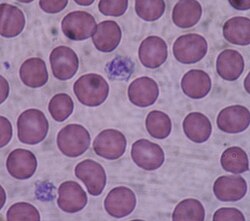പ്ലേറ്റ്ലെറ്റ്
പ്ലേറ്റ്ലെറ്റുകൾ അല്ലെങ്കിൽ ത്രോംബോസൈറ്റുകൾ, രക്തത്തിലെ ചെറുതും നിറമില്ലാത്തതുമായ കോശ ശകലങ്ങളാണ്, അത് രക്തം കട്ടപിടിക്കുന്നതിനും അതുവഴി രക്തസ്രാവം തടയുന്നതിനും സഹായിക്കുന്നു. അസ്ഥിമജ്ജയിലാണ് പ്ലേറ്റ്ലെറ്റുകൾ നിർമ്മിക്കുന്നത്.[1] ആരോഗ്യമുള്ള ശരീരത്തിലെ രക്തത്തിൽ ഏകദേശം 1,50,000 മുതൽ 4,50,000വരെ പ്ലേറ്റ്ലെറ്റുകൾ അടങ്ങിയിട്ടുണ്ട്. മെഗാകാരിയോസൈറ്റുകൾ എന്ന കോശങ്ങളിൽ നിന്നാണ് പ്ലേറ്റ്ലെറ്റുകൾ ഉണ്ടാവുന്നത്.
| Platelet | |
|---|---|
 | |
| Image from a light microscope (40×) from a peripheral blood smear surrounded by red blood cells. One normal platelet can be seen in the upper left side of the image (purple) and is significantly smaller in size than the red blood cells (stained pink). Two giant platelets (stained purple) are also visible. | |
| ലാറ്റിൻ | thrombocytes |

രോഗങ്ങൾ
തിരുത്തുക- രക്തസ്രാവം-പ്ലേറ്റ്ലെറ്റുകളുടെ എണ്ണം കുറഞ്ഞാൽ രക്തം കട്ട പിടിക്കാതിരിക്കുകയും രക്തസ്രാവം ഉണ്ടാകുകയും ചെയ്യും.
- ഹ്യദയാഘാതം-പ്ലേറ്റ്ലെറ്റുകൾ അമിതമായി ഹ്യദയധമനികളിൽ അടിഞ്ഞുചേർന്നാൽ ഹ്യദയ പേശികൾക്ക് ഓക്സിജൻ ലഭിക്കാതെ ഹ്യദയാഘാതം സംഭവിക്കാം.
വൈകല്യങ്ങളുടെ അടയാളങ്ങളും ലക്ഷണങ്ങളും
തിരുത്തുകപ്ലേറ്റ്ലെറ്റ് തകരാറുകൾ കാരണം സ്വയമേവയുള്ളതും അമിതമായതുമായ രക്തസ്രാവം സംഭവിക്കാം. പ്ലേറ്റ്ലെറ്റുകളുടെ കുറവ്, പ്രവർത്തനരഹിതമായ പ്ലേറ്റ്ലെറ്റുകൾ അല്ലെങ്കിൽ പ്ലേറ്റ്ലെറ്റുകളുടെ അമിതമായ (1.0 മില്ല്യൺ/മൈക്രോലിറ്റർ) എണ്ണം എന്നിവ കാരണം ഈ രക്തസ്രാവം ഉണ്ടാകാം (അധിക സംഖ്യകൾ സീക്വസ്ട്രേഷൻ കാരണം ആപേക്ഷിക വോൺ വില്ലെബ്രാൻഡ് ഫാക്ടർ ഡിഫിഷ്യൻസി ഉണ്ടാക്കുന്നു).[2][3]
മരുന്നുകൾ
തിരുത്തുകആസ്പിരിൻ- പ്ലേറ്റ്ലറ്റ് അടിഞ്ഞു കൂടുന്നത് തടയുന്നു.[4] ക്ലോപിഡോഗ്രൽ - പ്ലേറ്റ്ലറ്റ് അടിഞ്ഞു കൂടുന്നത് തടയുന്നു.
മറ്റ് മൃഗങ്ങൾ
തിരുത്തുകപ്ലേറ്റ്ലെറ്റുകൾക്ക് പകരം, സസ്തനികളല്ലാത്ത കശേരുക്കൾക്ക് ന്യൂക്ലിയേറ്റഡ് ത്രോംബോസൈറ്റുകളാണ് ഉള്ളത്, അവ രൂപശാസ്ത്രത്തിൽ ബി ലിംഫോസൈറ്റുകളോട് സാമ്യമുള്ളതാണ്. ത്രോംബിനോടുള്ള പ്രതികരണമായി അവ അഗ്രിഗേറ്റ് ചെയ്യുന്നുവെങ്കിലും പ്ലേറ്റ്ലെറ്റുകൾ ചെയ്യുന്നതുപോലെ അവ എഡിപി, സെറോടോണിൻ, അഡ്രിനാലിൻ എന്നിവയുമായി ചേരുന്നില്ല.[5][6]
അവലംബം
തിരുത്തുക- ↑ "What Are Platelets In Blood" (in ഇംഗ്ലീഷ്). Retrieved 2023-08-15.
- ↑ Murakawa M, Okamura T, Tsutsumi K, Tanoguchi S, Kamura T, Shibuya T, Harada M, Niho Y (1992). "Acquired von Willebrand's disease in association with essential thrombocythemia: regression following treatment". Acta Haematologica. 87 (1–2): 83–7. doi:10.1159/000204725. PMID 1585777.
- ↑ van Genderen PJ, Leenknegt H, Michiels JJ, Budde U (September 1996). "Acquired von Willebrand disease in myeloproliferative disorders". Leukemia & Lymphoma. 22 Suppl 1: 79–82. doi:10.3109/10428199609074364. PMID 8951776.
- ↑ http://www.nejm.org/doi/full/10.1056/NEJM198308183090703
- ↑ Schmaier AA, Stalker TJ, Runge JJ, Lee D, Nagaswami C, Mericko P, Chen M, Cliché S, Gariépy C, Brass LF, Hammer DA, Weisel JW, Rosenthal K, Kahn ML (September 2011). "Occlusive thrombi arise in mammals but not birds in response to arterial injury: evolutionary insight into human cardiovascular disease". Blood. 118 (13): 3661–9. doi:10.1182/blood-2011-02-338244. PMC 3186337. PMID 21816834.
- ↑ Belamarich FA, Shepro D, Kien M (November 1968). "ADP is not involved in thrombin-induced aggregation of thrombocytes of a non-mammalian vertebrate". Nature. 220 (5166): 509–10. Bibcode:1968Natur.220..509B. doi:10.1038/220509a0. PMID 5686175. S2CID 4269208.